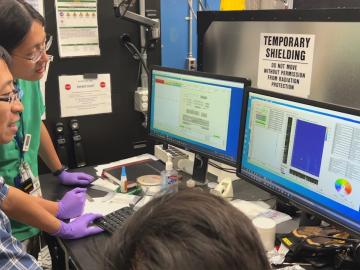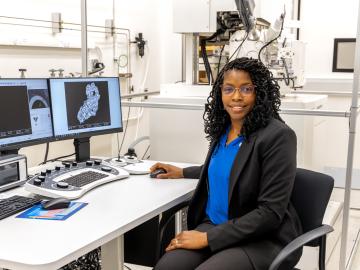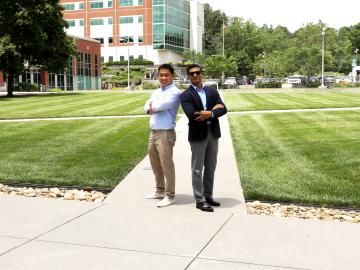
Filter News
Area of Research
- (-) National Security (37)
- (-) Neutron Science (41)
- (-) Supercomputing (88)
- Advanced Manufacturing (22)
- Biology and Environment (34)
- Biology and Soft Matter (1)
- Building Technologies (1)
- Computational Engineering (1)
- Computer Science (8)
- Electricity and Smart Grid (3)
- Energy Science (181)
- Energy Sciences (1)
- Functional Materials for Energy (2)
- Fusion and Fission (14)
- Fusion Energy (3)
- Isotope Development and Production (1)
- Isotopes (5)
- Materials (134)
- Materials Characterization (1)
- Materials for Computing (20)
- Materials Under Extremes (1)
- Nuclear Science and Technology (11)
- Quantum information Science (2)
- Sensors and Controls (1)
- Transportation Systems (1)
News Topics
- (-) 3-D Printing/Advanced Manufacturing (12)
- (-) Chemical Sciences (7)
- (-) Cybersecurity (23)
- (-) Energy Storage (15)
- (-) Frontier (33)
- (-) Grid (11)
- (-) Machine Learning (26)
- (-) Materials Science (33)
- (-) Quantum Computing (20)
- (-) Space Exploration (5)
- Advanced Reactors (3)
- Artificial Intelligence (49)
- Big Data (26)
- Bioenergy (16)
- Biology (18)
- Biomedical (28)
- Biotechnology (3)
- Buildings (4)
- Clean Water (2)
- Composites (1)
- Computer Science (108)
- Coronavirus (21)
- Critical Materials (3)
- Environment (33)
- Exascale Computing (26)
- Fossil Energy (1)
- Fusion (3)
- High-Performance Computing (46)
- Hydropower (1)
- Isotopes (2)
- Materials (29)
- Mathematics (2)
- Microscopy (8)
- Molten Salt (1)
- Nanotechnology (19)
- National Security (36)
- Neutron Science (122)
- Nuclear Energy (10)
- Partnerships (5)
- Physics (18)
- Polymers (3)
- Quantum Science (31)
- Security (15)
- Simulation (16)
- Software (1)
- Summit (43)
- Transportation (12)
Media Contacts

Tom Karnowski and Jordan Johnson of ORNL have been named chair and vice chair, respectively, of the East Tennessee section of the Institute of Electrical and Electronics Engineers, or IEEE.

Neutron experiments can take days to complete, requiring researchers to work long shifts to monitor progress and make necessary adjustments. But thanks to advances in artificial intelligence and machine learning, experiments can now be done remotely and in half the time.

Outside the high-performance computing, or HPC, community, exascale may seem more like fodder for science fiction than a powerful tool for scientific research. Yet, when seen through the lens of real-world applications, exascale computing goes from ethereal concept to tangible reality with exceptional benefits.

Mike Huettel is a cyber technical professional. He also recently completed the 6-month Cyber Warfare Technician course for the United States Army, where he learned technical and tactical proficiency leadership in operations throughout the cyber domain.

Cody Lloyd became a nuclear engineer because of his interest in the Manhattan Project, the United States’ mission to advance nuclear science to end World War II. As a research associate in nuclear forensics at ORNL, Lloyd now teaches computers to interpret data from imagery of nuclear weapons tests from the 1950s and early 1960s, bringing his childhood fascination into his career

Quantum computing sits on the cutting edge of scientific discovery. Given its novelty, the next generation of researchers will contribute significantly to the advancement of the field. However, this new crop of scientists must first be cultivated.

After completing a bachelor’s degree in biology, Toya Beiswenger didn’t intend to go into forensics. But almost two decades later, the nuclear security scientist at ORNL has found a way to appreciate the art of nuclear forensics.

Wildfires have shaped the environment for millennia, but they are increasing in frequency, range and intensity in response to a hotter climate. The phenomenon is being incorporated into high-resolution simulations of the Earth’s climate by scientists at the Department of Energy’s Oak Ridge National Laboratory, with a mission to better understand and predict environmental change.

When geoinformatics engineering researchers at the Department of Energy’s Oak Ridge National Laboratory wanted to better understand changes in land areas and points of interest around the world, they turned to the locals — their data, at least.

With the world’s first exascale supercomputer now fully open for scientific business, researchers can thank the early users who helped get the machine up to speed.


